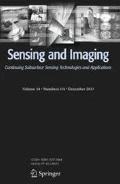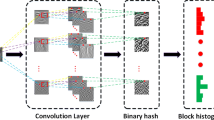Abstract
Compared to supervised learning, unsupervised learning allows systems to learn consistent patterns from cheap and abundant unlabeled data, without the need for manual annotation. In this paper, we present a novel unsupervised feature learning method with single layer (SL) network based independent component analysis (ICA) filters called SL-ICANet, with the goal of achieving compact and robust facial feature representation. Our contributions are twofold: (i) We developed a single-layer convolutional network for unsupervised learning wherein the trainable kernels are replaced by ICA filters. (ii) We extended our SL-ICANet to use multi-scale information for better feature learning. Extensive experiments on two popular face recognition benchmarks, namely, labeled faces in the wild and facial recognition technology show that the proposed method might serve as a simple but highly competitive baseline for face recognition.





Similar content being viewed by others
References
Ahonen, T., Hadid, A., & Pietikainen, M. (2006). Face description with local binary patterns: Application to face recognition. IEEE Transactions on Pattern Analysis and Machine Intelligence, 28(12), 2037–2041.
Belhumeur, P. N., Hespanha, J. P., & Kriegman, D. J. (1997). Eigenfaces vs. fisherfaces: Recognition using class specific linear projection. IEEE Transactions on Pattern Analysis and Machine Intelligence, 19(7), 711–720.
Chan, T.-H., Jia, K., Gao, S., Jiwen, L., Zeng, Z., & Ma, Y. (2015). Pcanet: A simple deep learning baseline for image classification? IEEE Transactions on Image Processing, 24(12), 5017–5032.
Dalal, N., & Triggs, B. (2005). Histograms of oriented gradients for human detection. In IEEE computer society conference on computer vision and pattern recognition, 2005. CVPR 2005 (Vol. 1, pp. 886–893). IEEE.
Huang, G. B., Ramesh, M., Berg, T., & Learned-Miller, E. (2007). Labeled faces in the wild: A database for studying face recognition in unconstrained environments. In Technical report, Technical Report 07-49 Amherst: University of Massachusetts.
Jiwen, L., Tan, Y.-P., & Wang, G. (2013). Discriminative multimanifold analysis for face recognition from a single training sample per person. IEEE Transactions on Pattern Analysis and Machine Intelligence, 35(1), 39–51.
Kannala, J., & Rahtu, E. (2012). Bsif: Binarized statistical image features. In 2012 21st international conference on pattern recognition (ICPR) (pp. 1363–1366). IEEE.
Lin, M., Chen, Q., & Yan, S. (2013). Network in network. arXiv preprint arXiv:1312.4400.
Liu, C., & Wechsler, H. (2002). Gabor feature based classification using the enhanced fisher linear discriminant model for face recognition. IEEE Transactions on Image processing, 11(4), 467–476.
Lowe, D. G. (1999). Object recognition from local scale-invariant features. In The proceedings of the seventh IEEE international conference on computer vision, 1999 (Vol. 2, pp. 1150–1157). IEEE.
Nguyen, H. V., Bai, L., & Shen, L. (2009). Local gabor binary pattern whitened pca: A novel approach for face recognition from single image per person. In International conference on biometrics (pp. 269–278). Springer, Berlin, Heidelberg.
Parkhi, O. M., Vedaldi, A., & Zisserman, A. (2015). Deep face recognition. In BMVC (Vol. 1, No. 3, p. 6).
Phillips, P. J., Flynn, P. J., Scruggs, T., Bowyer, K. W., Chang, J., Hoffman, K., Marques, J., Min, J., & Worek, W. (2005). Overview of the face recognition grand challenge. In IEEE computer society conference on computer vision and pattern recognition, 2005. CVPR 2005 (Vol. 1, pp. 947–954). IEEE.
Phillips, P. J., Moon, H., Rizvi, S. A., & Rauss, P. J. (2000). The FERET evaluation methodology for face-recognition algorithms. IEEE Transactions on Pattern Analysis and Machine Intelligence, 22(10), 1090–1104.
Rodrigo, V., & Correa, M. (2009). Recognition of faces in unconstrained environments: A comparative study. EURASIP Journal on Advances in Signal Processing, 2009(1), 184617.
Schroff, F., Kalenichenko, D., & Philbin, J. (2015). Facenet: A unified embedding for face recognition and clustering. In Proceedings of the IEEE conference on computer vision and pattern recognition (pp. 815–823).
Seo, H. J., & Milanfar, P. (2011). Face verification using the lark representation. IEEE Transactions on Information Forensics and Security, 6(4), 1275–1286.
Sharma, G., ul Hussain, S., & Jurie, F. (2012). Local higher-order statistics (LHS) for texture categorization and facial analysis. In European conference on computer vision (pp. 1–12). Springer, Berlin, Heidelberg.
Simonyan, K., & Zisserman, A. (2014). Very deep convolutional networks for large-scale image recognition. arXiv preprint arXiv:1409.1556.
Simonyan, K., Parkhi, O. M., Vedaldi, A., & Zisserman, A. (2013). Fisher vector faces in the wild. In BMVC (Vol. 2, p. 4).
Sun, Y., Chen, Y., Wang, X., & Tang, X. (2014). Deep learning face representation by joint identification-verification. In Advances in neural information processing systems (pp. 1988–1996).
Sun, Y., Liang, D., Wang, X, & Tang, X. (2015). Deepid3: Face recognition with very deep neural networks. arXiv preprint arXiv:1502.00873.
Sun, Y., Wang, X., & Tang, X. (2014). Deep learning face representation from predicting 10,000 classes. In Proceedings of the IEEE conference on computer vision and pattern recognition (pp. 1891–1898).
Sun, Y., Wang, X., & Tang, X. (2015). Deeply learned face representations are sparse, selective, and robust. In Proceedings of the IEEE conference on computer vision and pattern recognition (pp. 2892–2900).
Tan, X., & Triggs, B. (2010). Enhanced local texture feature sets for face recognition under difficult lighting conditions. IEEE Transactions on Image Processing, 19(6), 1635–1650.
Turk, M. A., & Pentland, A. P. (1991). Face recognition using eigenfaces. In IEEE computer society conference on computer vision and pattern recognition, 1991, Proceedings CVPR’91 (pp. 586–591). IEEE.
Wen, Y., Zhang, K., Li, Z., & Qiao, Y. (2016). A discriminative feature learning approach for deep face recognition. In European conference on computer vision (pp. 499–515). Berlin: Springer.
Xi, M., Chen, L., Polajnar, D., & Tong, W. (2016). Local binary pattern network: A deep learning approach for face recognition. In IEEE international conference on image processing (ICIP), 2016 (pp. 3224–3228). IEEE.
Yi, D., Lei, Z., Liao, S., & Li, S. Z. (2014). Learning face representation from scratch. arXiv preprint arXiv:1411.7923
Yi, D., Lei, Z., Liao, S., & Li, S. Z. (2014). Learning face representation from scratch. arXiv preprint arXiv:1411.7923.
Ylioinas, J., Kannala, J., Hadid, A., & Pietikäinen, M. (2015). Face recognition using smoothed high-dimensional representation. In Scandinavian conference on image analysis (pp. 516–529). Berlin: Springer.
Acknowledgements
This work is supported by National Natural Science Foundation of China (Grant Nos. 61402307, 61702058) National Key Scientific Instrument and Equipment Development Project of China (No. 2013YQ49087903), the Scientific Research Foundation of CUIT (Nos. KYTZ201717, J201706) and the China Postdoctoral Science and Foundation No. 2017M612948.
Author information
Authors and Affiliations
Corresponding author
Additional information
This article is part of the Topical Collection on Recent Developments in Sensing and Imaging.
Rights and permissions
About this article
Cite this article
Geng, T., Zhang, Y., Cai, Y. et al. Unsupervised Feature Learning with Single Layer ICANet for Face Recognition. Sens Imaging 19, 5 (2018). https://doi.org/10.1007/s11220-018-0188-9
Received:
Revised:
Published:
DOI: https://doi.org/10.1007/s11220-018-0188-9




